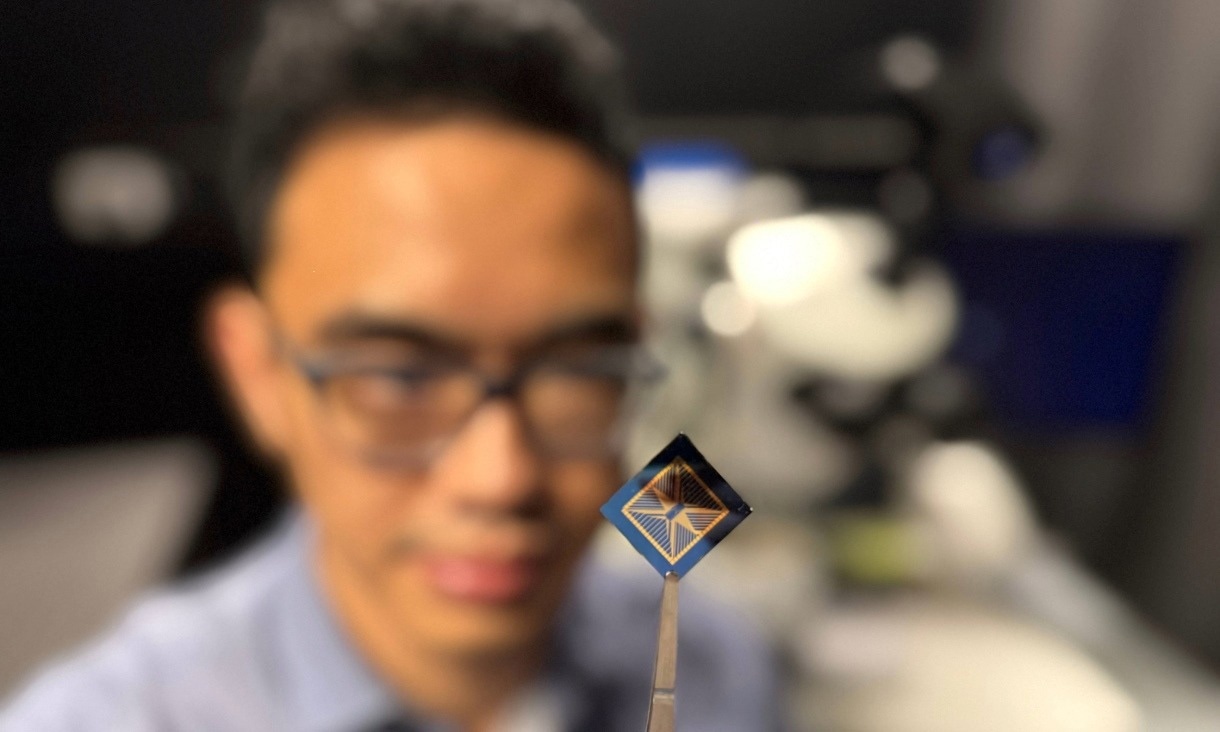Engineers at RMIT University, under the direction of Professor Sumeet Walia, have developed a compact “neuromorphic” device capable of detecting hand movements, storing memories, and processing information like the human brain, all without requiring an external computer. The invention enables instant visual processing in advanced robotics, driverless cars, and other next-generation applications for better human interaction. The journal Advanced Materials Technologies published the study.
 RMIT PhD Scholar and Study First Author Thiha Aung inspects the team's neuromorphic vision device. Image Credit: Will Wright, RMIT University
RMIT PhD Scholar and Study First Author Thiha Aung inspects the team's neuromorphic vision device. Image Credit: Will Wright, RMIT University
Neuromorphic vision systems are designed to use similar analogue processing to our brains, which can greatly reduce the amount of energy needed to perform complex visual tasks compared with digital technologies used today.
Sumeet Walia, Director, Centre for Opto-electronic Materials and Sensors, RMIT University
Professor Akram Al-Hourani, Deputy Director of COMAS, heads the project, which combines advanced signal processing with neuromorphic materials.
Molybdenum disulfide, or MoS2, is a metal compound found in the device.
In their most recent study, the team demonstrated how atomic-scale flaws in this substance can absorb light and convert it into electrical signals, much like neurons do in the human brain.
This proof-of-concept device mimics the human eye’s ability to capture light and the brain’s ability to process that visual information, enabling it to sense a change in the environment instantly and make memories without the need for using huge amounts of data and energy. Current digital systems, by contrast, are very power hungry and unable to keep up as data volume and complexity increases, which limits their ability to make ‘true’ real-time decisions.
Sumeet Walia, Director, Centre for Opto-electronic Materials and Sensors, RMIT University
Walia and Al-Hourani are corresponding authors, while Mr. Thiha Aung, a PhD Candidate at RMIT, is the First Author.
RMIT has submitted a provisional patent application.
Seeing the Future in the Wave of a Hand
Edge detection, which uses less power and data processing, is how the device identifies changes in a waving hand's movement during experiments without recording the action frame by frame.
Like a brain, the device stored these events as memories after detecting the changes.
The researchers carried out experiments in the visible spectrum based on the team's earlier neuromorphic studies in the ultraviolet domain.
We demonstrated that atomically thin molybdenum disulfide can accurately replicate the leaky integrate-and-fire (LIF) neuron behaviour, a fundamental building block of spiking neural networks.
Thiha Aung, Study First Author, RMIT University
The previous UV work was limited to still image processing, memory creation, and detection. Memories could be reset in UV and visible-spectrum devices, preparing them for the subsequent task.
Potential Applications
One day, the team's invention might speed up automated cars and sophisticated robotic systems' reactions to visual cues, which could be vital in hazardous and uncertain situations.
“Neuromorphic vision in these applications, which is still many years away, could detect changes in a scene almost instantly, without the need to process lots of data, enabling a much faster response that could save lives,” Walia said.
“For robots working closely with humans in manufacturing or as a personal assistant, neuromorphic technology could enable more natural interactions by recognising and reacting to human behaviour with minimal delay,” Al-Hourani said.
Next Steps
The group is expanding the single-pixel proof-of-concept device to a larger array of MoS2-based devices.
The team recently received funding from the Australian Research Council through a Linkage Infrastructure, Equipment and Facilities (LIEF) grant to facilitate the scaling up of their neuromorphic devices.
Walia said, “While our system mimics certain aspects of the brain’s neural processing, particularly in vision, it is still a simplified model. We will optimise the devices to perform specific real-world applications with more complex vision tasks, and further reduce power consumption.”
The group intends to create hybrid systems combining traditional digital electronics with analog technology.
Walia said, “We see our work as complementary to traditional computing, rather than a replacement. Conventional systems excel at many tasks, while our neuromorphic technology offers advantages for visual processing where energy efficiency and real-time operation are critical.”
In addition to MoS2, the team is looking into materials that could expand capabilities into the infrared, allowing for intelligent sensing of contaminants like chemicals, pathogens, and toxic gases, as well as real-time tracking of global emissions.
Journal Reference:
Aung, T., et al. (2025) Photoactive Monolayer MoS2 for Spiking Neural Networks Enabled Machine Vision Applications. Advanced Materials Technologies. doi.org/10.1002/admt.202401677.